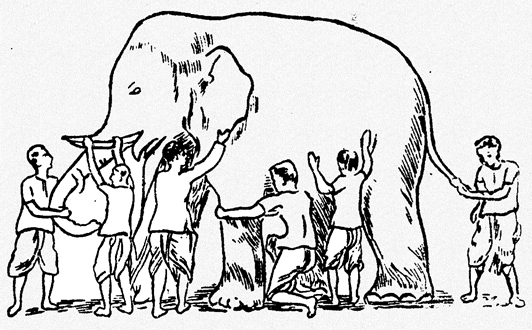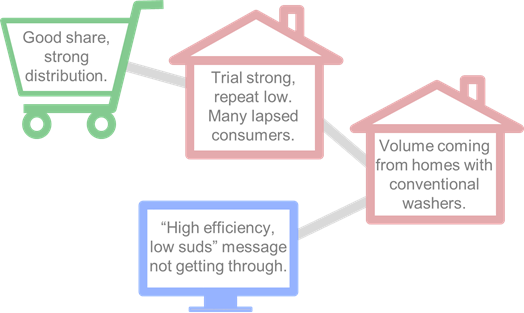-
Quantitative Research
Quantitative Research
Problem Definition
Research Design
Questionnaire Design
Order Effects and Order Bias
Open-ended and Close-ended Questions
Information Needs
Behaviour Questions
Classification Questions
Attitude Questions
Likert Scale
Factor Analysis and Regression
Rating Scale
Guidelines on Constructing Questions
Sampling
Data Collection
Online Research
Analysis Process
Interpretation & Recommendations
- Segmentation
- Qualitative Research
- Quantitative Research
- Customer Satisfaction and Customer Value
- Consumer Panels and Consumer Analytics
- Big Data and Consumer Analytics
- Marketing Education
- Is Marketing Education Fluffy and Weak?
- How to Choose the Right Marketing Simulator
- Self-Learners: Experiential Learning to Adapt to the New Age of Marketing
- Negotiation Skills Training for Retailers, Marketers, Trade Marketers and Category Managers
- Simulators becoming essential Training Platforms
- What they SHOULD TEACH at Business Schools
- Experiential Learning through Marketing Simulators
-
MarketingMind
Quantitative Research
Quantitative Research
Problem Definition
Research Design
Questionnaire Design
Order Effects and Order Bias
Open-ended and Close-ended Questions
Information Needs
Behaviour Questions
Classification Questions
Attitude Questions
Likert Scale
Factor Analysis and Regression
Rating Scale
Guidelines on Constructing Questions
Sampling
Data Collection
Online Research
Analysis Process
Interpretation & Recommendations
- Segmentation
- Qualitative Research
- Quantitative Research
- Customer Satisfaction and Customer Value
- Consumer Panels and Consumer Analytics
- Big Data and Consumer Analytics
- Marketing Education
- Is Marketing Education Fluffy and Weak?
- How to Choose the Right Marketing Simulator
- Self-Learners: Experiential Learning to Adapt to the New Age of Marketing
- Negotiation Skills Training for Retailers, Marketers, Trade Marketers and Category Managers
- Simulators becoming essential Training Platforms
- What they SHOULD TEACH at Business Schools
- Experiential Learning through Marketing Simulators
Interpretation and Recommendation
The Elephant and the Blind Men
Once upon a time, there lived six blind men in a village. One day the villagers told them, “Hey, there is an elephant in the village today.”
They had no idea what an elephant was like. They decided, “Even though we would not be able to see it, let us go and feel it anyway.” All of them went where the elephant was. Every one of them touched the elephant (Exhibit 5.4).
“Hey, the elephant is a pillar,” said the first man who touched his leg.
“Oh, no! It is like a rope,” said the second man who touched the tail.
“Oh, no! It is like a thick branch of a tree,” said the third man who touched the trunk of the elephant.
“It is like a big hand fan” said the fourth man who touched the ear of the elephant.
“It is like a huge wall,” said the fifth man who touched the belly of the elephant.
“It is like a solid pipe,” Said the sixth man who touched the tusk of the elephant.
Source: (Jain World).
Data Linkages
Data is like a jigsaw puzzle; you need to put the pieces together to see the big picture. Individually each piece is factually true — depending on the touchpoint, the elephant has the shape of a pillar, a rope, a branch, a fan, a wall or a pipe. Yet, these conclusions from individual snippets of data are misleading.
Much like the elephant, the business issue must be addressed from different angles. You need to fully immerse in the data, tracing the pieces, and putting them together to form the complete picture. Most market metrics need to be examined in conjunction with other metrics, not only because each alone presents a restricted view, but also because individual research methodologies have limitations and constraints.
The picture in its entirety is often revealed by looking beyond the confines of a single research study, linking different research studies/sources of knowledge to enhance your understanding of the issues, and improve your confidence in the findings. This use of multiple approaches to examine an issue, in order to enhance confidence in the ensuing findings, is referred to as triangulation.
Facts gleaned from any research programme need to be critically examined. Answers often lead to more questions. It is often useful to examine sub-samples and drill deeper for an improved understanding of the marketing issues, provided the data remains statistically significant. Eventually a coherent scenario should emerge.
For example, consider Exhibit 5.5 which pieces together snippets of information about the launch of a new high efficiency detergent.
The findings from retail tracking revealed that the product was well distributed, and market share was above expectations. The conclusions from the quantitative research, however, revealed that though the proportion of consumers who tried this product was quite high, there were many lapsed buyers. This typically is a sign that the brand did not meet the expectations of the consumers who tried it — was there a problem with the product’s quality?
Drilling deeper, we realized that the homes trying the detergent powder were primarily having conventional washing machines, whereas the new detergent was intended for high efficiency washers. Lapsed users were reverting back to the conventional detergent brands that they were accustomed to buying.
Consumer panel analysis confirmed that trial rate was high and the repeat buying rate was low. It also predicted that, if corrective actions were not taken, the market share of the new brand will decline to a level that would not meet target expectations.
By filtering the data, we were able to conclude that the repeat buying rate was good among those users who were the intended target. The problem, therefore, was that the brand was not attracting enough of these users.
Qualitative research commissioned at that time, revealed that the key advertising message “high efficiency, low suds”, was not registering with target consumers.
Piecing together snippets from diverse data sources equips marketers to make better-informed decisions. In this example, while the low repeat rates and high lapsed usage may have suggested an issue with the product, by drilling deeper into the data and examining multiple sources, it became apparent that the real issue was communication, not product quality.
It is not necessarily desirable that marketers commission multiple research studies to address business issues. That may be too expensive for small or medium-sized brands. What is important is that marketers effectively use their existing sources of information, and that they arrive at conclusions after exhausting plausible, alternative explanations.
Previous
Use the Search Bar to find content on MarketingMind.
Contact | Privacy Statement | Disclaimer: Opinions and views expressed on www.ashokcharan.com are the author’s personal views, and do not represent the official views of the National University of Singapore (NUS) or the NUS Business School | © Copyright 2013-2025 www.ashokcharan.com. All Rights Reserved.







